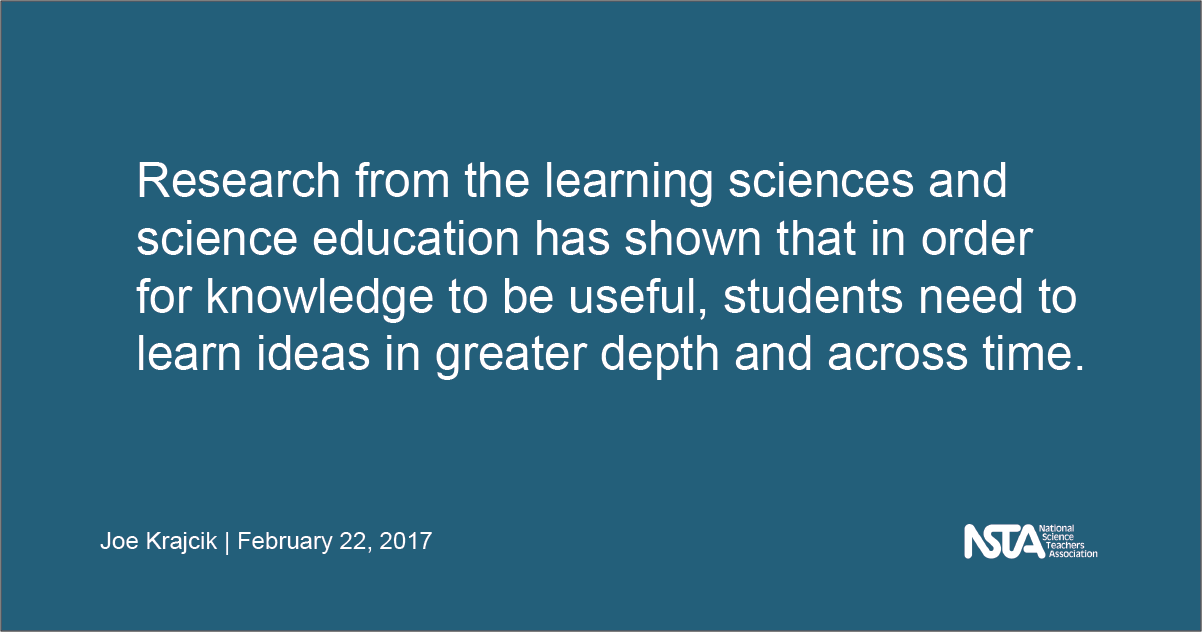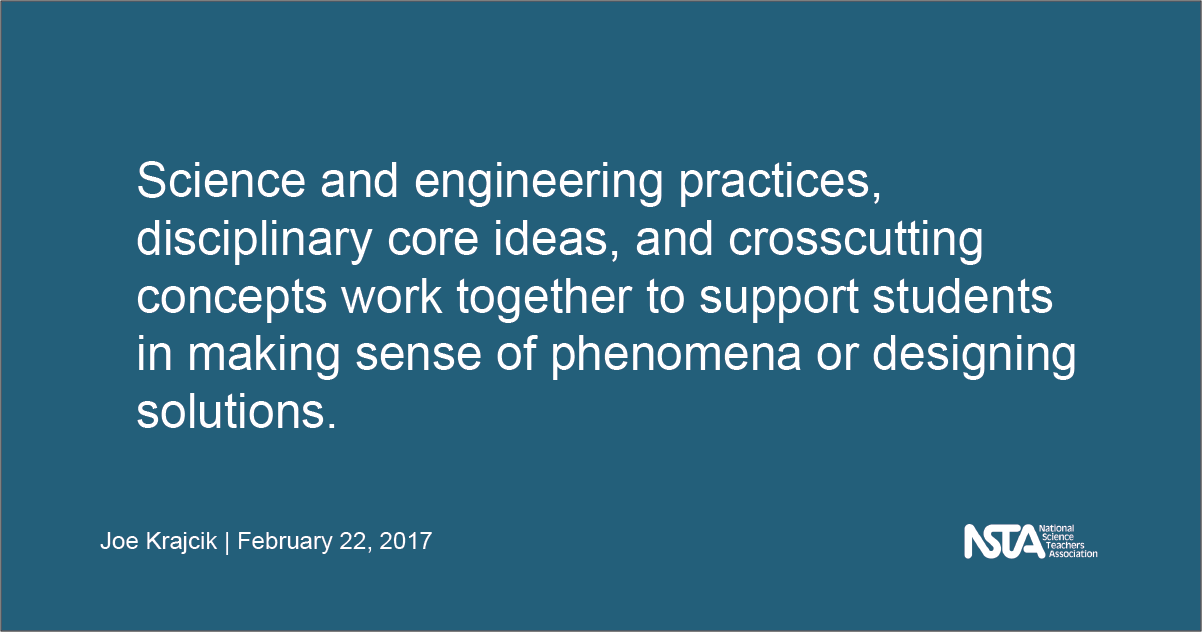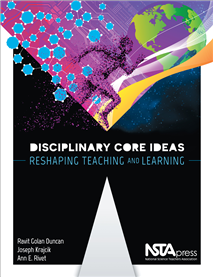What's So Special About Disciplinary Core Ideas? (Part 3)
By Joe Krajcik
Posted on 2017-02-22

DCIs Develop Across Time
The first two blogs in my series on disciplinary core ideas (DCIs) focused on how DCIs form a conceptual framework and that DCIs provide explanations for a variety of phenomena. In this final blog I’d like to focus on an important idea reflected in A Framework for K–12 Science Education (Framework) that DCIs are not stand-alone, individual facts that students come to “know” as the result of one lesson or across one grade. Rather, DCIs develop in ways that become progressively more sophisticated as students use those ideas to make sense of new phenomena or problems within and across the grade levels. What is meant by more sophisticated? It means that students’ explanations become deeper and broader allowing them to explain more fully the causes and consequences of a wider array of related phenomena. Sophistication also means that DCIs become integrated with more ideas and experiences. Sophistication is not acquiring more ideas and more details; rather, it is about making connections to ideas and experiences. As ideas get more sophisticated, students come to understand the cause and effect mechanisms that underlie a range of phenomena.
Research from the learning sciences and science education has shown that in order for knowledge to be useful, students need to learn ideas in greater depth and across time. The DCIs are introduced to students in early grades and develop throughout the K–12 years and beyond. As such, core ideas form a strong foundation to promote continual learning throughout one’s life. Building ideas across time supports learners in developing deeper and more meaningful and sophisticated understandings by forming connections among ideas. These connections will allow learners to apply the understandings to new and novel situations.
For most science educators, taking a developmental approach to teaching science is new. As teachers and curriculum designers, we need to carefully link new learning and experiences to what students have previously learned, allowing the ideas to become more sophisticated over time. The idea of building on previous ideas is one of the most solid ideas in learning; unfortunately, in the past we’ve seldom given it the attention it deserves. For example, some textbooks present ideas about the water cycle that are dependent on understanding that matter is made of particles, without providing the help students need to develop this idea. The Framework emphasizes the importance of taking a developmental perspective focused on developing ideas over time and building on students’ prior knowledge and experiences.
A developmental perspective requires us, as teachers and curriculum designers, to build and link to students’ current understanding to form richer and more connected ideas over time (NRC 2007). Disciplinary core ideas should develop from elementary through high school. Each year the ideas become more sophisticated, allowing students to provide more complete explanations of phenomena as well as explain more phenomena.
A developmental perspective guides students’ knowledge toward a more sophisticated and integrated understanding of the scientific idea. For example, if by the end of 5th grade we can help students know and apply the idea that forces acting on an object can cause changes in the object’s speed or direction, we can help learners in later grades develop deeper ideas of forces, including those at the intermolecular level. Similarly, helping 3rd-grade students understand that changes in the environment will cause some organisms to survive and reproduce, others to move to a new location, and others to die off, can lead to deeper understanding of natural selection and evolution in middle school and high school. The grade band endpoints in the Framework show this progression of ideas across time. In Disciplinary Core Ideas: Reshaping Teaching and Learning (Duncan, Krajcik, & Ravit 2016) various chapters on the DCIs discuss how they develop across time. Examples of how teachers can support student learning at various steps is also presented and discussed.
The developmental perspective also stresses that teaching more content, devoid from the use and application of those ideas, does not allow students to explain or reason about phenomena. Students can memorize science principles, but not really understand them. It helps to reflect back on our own experiences. I remember being able to solve the problems in my college physics class, but I didn’t understand the ideas behind what I was doing or how to apply those ideas to the world in which I lived.
It is critical to realize that growth in understanding is not developmentally inevitable, but depends on what we do in our teaching to provide key learning experiences that help students develop the ideas to become more sophisticated. Reaching the various endpoints depends on the instruction the student receives and how understanding is assessed. Disciplinary Core Ideas: Reshaping Teaching and Learning (Duncan, Krajcik & Ravit 2016) presents some ideas to move students from one level to another, but development of coherent curriculum materials that build understanding across time is needed.
Concluding Thoughts
 Deep, meaningful understanding of disciplinary core ideas are essential to predict and explain phenomena, but DCIs serve as only one dimension in developing this useable knowledge. Science and engineering practices, disciplinary core ideas, and crosscutting concepts work together to support students in making sense of phenomena or designing solutions. Rather than “learning” numerous disconnected ideas, the Framework focuses on helping learners develop a useable understanding of fewer, powerful ideas that develop across K–12-science curriculum and can form conceptual tools that learners can use to make sense of the world. Classroom instruction and curriculum materials will need to support students in reaching these important ideas. As such, curriculum materials and instruction focus on making sense of phenomena using the DCIs, scientific and engineering practices, and core ideas.
Deep, meaningful understanding of disciplinary core ideas are essential to predict and explain phenomena, but DCIs serve as only one dimension in developing this useable knowledge. Science and engineering practices, disciplinary core ideas, and crosscutting concepts work together to support students in making sense of phenomena or designing solutions. Rather than “learning” numerous disconnected ideas, the Framework focuses on helping learners develop a useable understanding of fewer, powerful ideas that develop across K–12-science curriculum and can form conceptual tools that learners can use to make sense of the world. Classroom instruction and curriculum materials will need to support students in reaching these important ideas. As such, curriculum materials and instruction focus on making sense of phenomena using the DCIs, scientific and engineering practices, and core ideas.
It is also important to realize that DCIs are for all students in our nation. All learners need to develop a sophisticated understanding of DCIs so that they can be used along with science and engineering practices and crosscutting concepts to make sense of the world. Developing useable knowledge will help ensure that we have a sustainable and free world in which to live. If given the chance I might tweak some of the physical science core ideas; but, I am convinced that the full spectrum of DCIs, along with the science and engineering practices, are good guides for our teaching and learning.
 I would love to hear from you about the ideas in this blog, your ideas, questions, and feedback. Tweet me at @krajcikjoe or email me krajcik@msu.edu. If you want to learn more about the disciplinary core ideas take a look at our new book, Disciplinary Core Ideas: Reshaping Teaching and Learning, edited by Ravit Duncan, Joe Krajcik, and Ann Rivet, just published by NSTA Press.
I would love to hear from you about the ideas in this blog, your ideas, questions, and feedback. Tweet me at @krajcikjoe or email me krajcik@msu.edu. If you want to learn more about the disciplinary core ideas take a look at our new book, Disciplinary Core Ideas: Reshaping Teaching and Learning, edited by Ravit Duncan, Joe Krajcik, and Ann Rivet, just published by NSTA Press.
References
American Association for the Advancement of Science (1993). Benchmarks for science literacy. New York: Oxford University Press.
Duncan, R., J. Krajcik, and A. Ravit eds. 2016. Disciplinary Core Ideas: Reshaping Teaching and Learning. Arlington, VA: National Science Teachers Association Press.
Fortus, D. and J. Krajcik. 2011. Curriculum Coherence and Learning Progressions in The International Handbook of Research in Science Education (second edition) Fraser, B. J., K. G. Tobin, and C. J. McRobbie, eds. Dordrecht: Springer.
National Research Council (NRC). 2012. A framework for K–12 science education: Practices, crosscutting concepts, and core ideas. Washington DC: National Academies Press.
Stevens, S., L. Sutherland, and J. S. Krajcik. 2009. The Big Ideas of Nanoscale Science and Engineering. Arlington, VA: National Science Teachers Association Press.
_____________________________________________________
Editor’s note: This blog is the last in a series of three by Joe Krajcik that explore the NGSS disciplinary core ideas.
Joe Krajcik (Krajcik@msu.edu) is a professor of science education at Michigan State University and director of the Institute for Collaborative Research for Education, Assessment, and Teaching Environments for Science, Technology and Engineering and Mathematics (CREATE for STEM). He served as Design Team Lead for both the Framework and the NGSS.
The mission of NSTA is to promote excellence and innovation in science teaching and learning for all.
Future NSTA Conferences
2017 National Conference
STEM Forum & Expo
Follow NSTA
Disclaimer: The views expressed in this blog post are those of the author(s) and do not necessarily reflect the official position of the National Science Teaching Association (NSTA).



